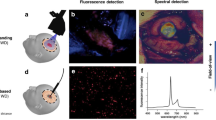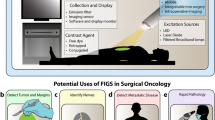Abstract
Purpose
Operative guidelines and use optimization for new surgical exoscopes are not well described in the literature. In this study, we evaluated use of the ORBEYE (Olympus) surgical exoscope system during 5-ALA fluorescence-guided resection of GBMs to optimize workflow and exoscope settings.
Methods
The ORBEYE exoscope system was fitted with a blue light filter for 5-ALA mediated fluorescence-guided surgery (FGS). Intraoperative images were obtained during 5-ALA FGS in 9 patients with primary or recurrent GBM. The exoscope was set up at constant, increasing focal distances from the target tissue, and light source intensity varied. High-resolution 4 K images were captured and analyzed. Comparisons of fluorescence to background were then generated for use optimization.
Results
Light intensity did not significantly influence tumor fluorescence (P = 0.878). However, focal distance significantly impacted relative fluorescent intensity (P = 0.007). Maximum average fluorescence was seen consistently at a focal length of 220 mm and a light intensity of approximately 75% maximum. Decreasing focal distance from 400 mm to 220 mm significantly increased visualized fluorescence (P = 0.0038).
Conclusions
The ORBEYE surgical exoscope system with blue light filter is a powerful imaging tool for 5-ALA FGS in GBM. The ORBEYE blue filter performs optimally at shorter focal distance with moderate light intensity. Similar to microscope systems, decreasing focal distance significantly influences visualized fluorescence.


Similar content being viewed by others
Abbreviations
- 5-ALA:
-
5-aminolevulinic acid
- ANOVA:
-
analysis of variance and covariance
- BL:
-
blue light
- FGS:
-
fluorescence-guided surgery
- FIJI:
-
Fiji is just imageJ
- EOR:
-
extent of resection
- GBM:
-
glioblastoma multiforme
- r-GBM:
-
recurrent glioblastoma multiforme
- IRB:
-
Internal Review Board
- MRI:
-
magnetic resonance imaging
- OS:
-
overall survival
- PFS:
-
progression-free survival
- RFU:
-
Relative fluorescence units
- STARD:
-
Standards for the Reporting of Diagnostic Accuracy Studies
- TIFF:
-
Tag Image File Format
References
Hadjipanayis CG, Widhalm G, Stummer W (2015) What is the surgical benefit of utilizing 5-aminolevulinic acid for fluorescence-guided surgery of malignant gliomas? Neurosurgery 77:663–673. https://doi.org/10.1227/neu.0000000000000929
Belykh E, Miller EJ, Patel AA, Bozkurt B, Yağmurlu K, Robinson TR, Nakaji P, Spetzler RF, Lawton MT, Nelson LY, Seibel EJ, Preul MC (2018) Optical characterization of neurosurgical operating microscopes: quantitative fluorescence and Assessment of PpIX Photobleaching. Sci Rep 8:12543. https://doi.org/10.1038/s41598-018-30247-6
Halani SH, Adamson DC (2016) Clinical utility of 5-aminolevulinic acid HCl to better visualize and more completely remove gliomas. Onco Targets Ther 9:5629–5642. https://doi.org/10.2147/ott.s97030
Maeda M, Nonaka M, Naito N, Ueno K, Kamei T, Asai A (2022) 5-ALA fluorescence-guided resection of pediatric low-grade glioma using the ORBEYE 3D digital exoscope: a technical report. Childs Nerv Syst. https://doi.org/10.1007/s00381-022-05612-6
Göttsche J, Piffko A, Pantel TF, Westphal M, Flitsch J, Ricklefs FL, Regelsberger J, Dührsen L (2022) Experiences with a 3D4K digital exoscope system (ORBEYE) in a wide range of neurosurgical procedures. J Neurol Surg A Cent Eur Neurosurg. https://doi.org/10.1055/a-1768-4060
Rotermund R, Regelsberger J, Osterhage K, Aberle J, Flitsch J (2021) 4K 3-dimensional video microscope system (orbeye) for transsphenoidal pituitary surgery. Acta Neurochir (Wien) 163:2097–2106. https://doi.org/10.1007/s00701-021-04762-x
Langer DJ, White TG, Schulder M, Boockvar JA, Labib M, Lawton MT (2020) Advances in intraoperative optics: a brief review of current exoscope platforms. Operative Neurosurg 19:84–93. https://doi.org/10.1093/ons/opz276
Goehre F, Ludtka C, Schwan S (2020) Ergonomics of surgical microscopes for the sitting position as determined by ocular-corpus length. Surg Neurol Int 11:244. https://doi.org/10.25259/sni_292_2020
Dadario NB, Khatri D, Reichman N, Nwagwu CD, D’Amico RS (2021) 5-aminolevulinic acid-shedding light on where to focus. World Neurosurg 150:9–16. https://doi.org/10.1016/j.wneu.2021.02.118
Stepp H, Stummer W (2018) 5-ALA in the management of malignant glioma. Lasers Surg Med 50:399–419. https://doi.org/10.1002/lsm.22933
Schindelin J, Arganda-Carreras I, Frise E, Kaynig V, Longair M, Pietzsch T, Preibisch S, Rueden C, Saalfeld S, Schmid B, Tinevez JY, White DJ, Hartenstein V, Eliceiri K, Tomancak P, Cardona A (2012) Fiji: an open-source platform for biological-image analysis. Nat Methods 9:676–682. https://doi.org/10.1038/nmeth.2019
Belykh E, Miller EJ, Hu D, Martirosyan NL, Woolf EC, Scheck AC, Byvaltsev VA, Nakaji P, Nelson LY, Seibel EJ, Preul MC (2018) Scanning fiber endoscope improves detection of 5-aminolevulinic acid-Induced protoporphyrin IX fluorescence at the boundary of infiltrative glioma. World Neurosurg 113:e51–e69. https://doi.org/10.1016/j.wneu.2018.01.151
Yen JC, Chang FJ, Chang S (1995) A new criterion for automatic multilevel thresholding. IEEE Trans Image Process 4:370–378. https://doi.org/10.1109/83.366472
Waters JC (2009) Accuracy and precision in quantitative fluorescence microscopy. J Cell Biol 185:1135–1148. https://doi.org/10.1083/jcb.200903097
Roberts DW, Olson JD, Evans LT, Kolste KK, Kanick SC, Fan X, Bravo JJ, Wilson BC, Leblond F, Marois M, Paulsen KD (2018) Red-light excitation of protoporphyrin IX fluorescence for subsurface tumor detection. J Neurosurg 128:1690–1697. https://doi.org/10.3171/2017.1.Jns162061
Sliney DH (2016) What is light? the visible spectrum and beyond. Eye 30:222–229. https://doi.org/10.1038/eye.2015.252
Stummer W, Tonn JC, Goetz C, Ullrich W, Stepp H, Bink A, Pietsch T, Pichlmeier U (2014) 5-aminolevulinic acid-derived tumor fluorescence: the diagnostic accuracy of visible fluorescence qualities as corroborated by spectrometry and histology and postoperative imaging. Neurosurgery 74:310–319. https://doi.org/10.1227/neu.0000000000000267. (discussion 319–320)
Vogelbaum MA, Kroll D, Etame A, Tran N, Liu J, Ford A, Sparr E, Kim Y, Forsyth P, Sahebjam S, Mokhtari S, Peguero E, Macaulay R (2021) A prospective validation study of the first 3D digital exoscope for visualization of 5-ALA-induced fluorescence in high-grade gliomas. World Neurosurg 149:e498–e503. https://doi.org/10.1016/j.wneu.2021.01.147
Funding
This study received support from Olympus Corporation of Americas.
Author information
Authors and Affiliations
Corresponding author
Ethics declarations
Conflict of interest
report no conflicts of interest. The authors alone are responsible for the content and writing of the article.
Additional information
Publisher’s Note
Springer Nature remains neutral with regard to jurisdictional claims in published maps and institutional affiliations.
Rights and permissions
Springer Nature or its licensor (e.g. a society or other partner) holds exclusive rights to this article under a publishing agreement with the author(s) or other rightsholder(s); author self-archiving of the accepted manuscript version of this article is solely governed by the terms of such publishing agreement and applicable law.
About this article
Cite this article
Witten, A.J., Ben-Shalom, N., Ellis, J.A. et al. Optimization of novel exoscopic blue light filter during fluorescence-guided resection of Glioblastoma. J Neurooncol 161, 617–623 (2023). https://doi.org/10.1007/s11060-022-04231-0
Received:
Accepted:
Published:
Issue Date:
DOI: https://doi.org/10.1007/s11060-022-04231-0




